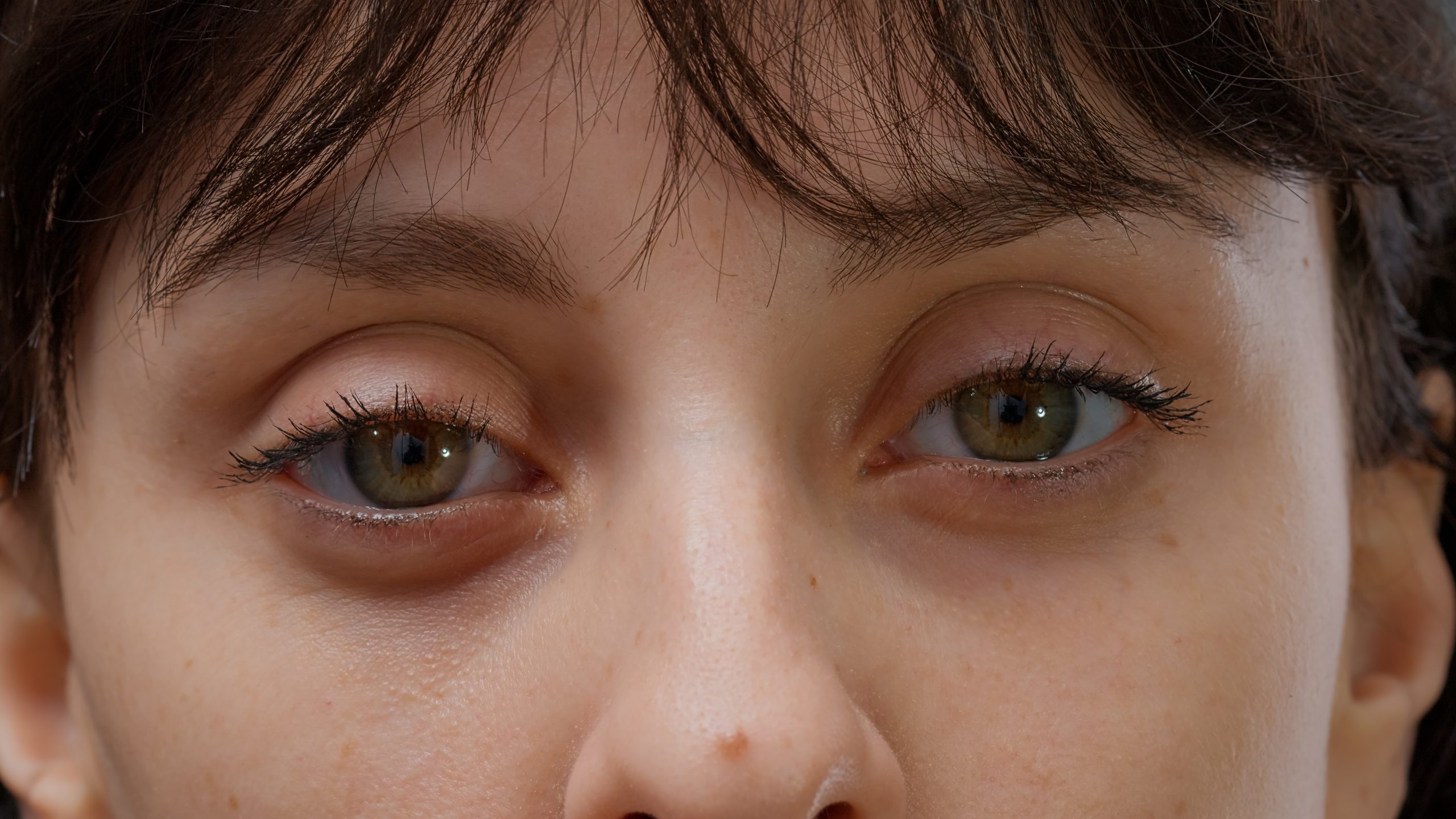Are your eyes feeling like they’ve been attacked by an army of itching, redness, and swelling? Well, you might be dealing with a case of eyelid dermatitis! In this article, we’ll dig deep into this common condition that loves to mess with your eyelid skin. Eyelid dermatitis can happen when your peepers come into contact with substances that set off an allergic reaction or irritation. Think dry, scaly, or rough skin, oozing or crusty skin, and puffy eyelids. There are different types of eyelid dermatitis, like allergic contact dermatitis and irritant contact dermatitis. Each has its own causes and triggers. Knowing the risks, complications, and how it’s diagnosed is crucial. We’ll also uncover treatment options and give you tips on managing this tricky condition. So, get ready to say goodbye to those pesky symptoms!
Symptoms of Eyelid Dermatitis
If you are experiencing dry, burning, itchy, or swollen eyelids, you may be showing symptoms of eyelid dermatitis. These symptoms can be uncomfortable and affect your daily life. It is important to identify and address the underlying causes of eyelid dermatitis to find relief and improve your overall eye health.
Dry skin
One common symptom of eyelid dermatitis is dry skin. When you have eyelid dermatitis, you may notice that your skin feels rough, scaly, and dehydrated. This dryness can be uncomfortable and may cause itching and irritation. To help alleviate these symptoms, there are various treatment options and home remedies you can try.
Here are some tips for managing dry skin caused by eyelid dermatitis:
- Moisturize regularly: Apply a gentle, fragrance-free moisturizer to your eyelids to hydrate the skin and prevent dryness.
- Avoid harsh chemicals: Be cautious about the products you use near your eyes, such as makeup removers, cleansers, and cosmetics, as they can exacerbate dryness.
- Protect your skin: Wear sunglasses or a hat to shield your eyelids from extreme weather conditions, like wind and cold temperatures.
Burning
When experiencing eyelid dermatitis, you may notice a burning sensation on your eyelids. This burning sensation can be quite uncomfortable and can contribute to overall eye discomfort. It is important to address this symptom in order to find relief and manage your condition effectively.
To help you understand more about burning sensation in eyelid dermatitis, here is a table outlining treatment options, prevention tips, common triggers, and home remedies:
| Treatment Options | Prevention Tips | Common Triggers | Home Remedies |
|---|---|---|---|
| Topical Steroids | Avoiding Allergens | Cosmetics | Cold Compresses |
| Moisturizers | Regular Eyelid | Soaps and Detergents | Aloe Vera Gel |
| Antihistamines | Cleansing | Dust | Chamomile Tea Bags |
| Cold Compresses | Hygiene | Chemicals | Cucumber Slices |
| Allergen Avoidance | Avoiding Irritants | Extreme Temperatures | Coconut Oil |
Itchy eyelids
To relieve itchy eyelids caused by eyelid dermatitis, try using moisturizers and avoiding irritants. Itching is one of the common symptoms of eyelid dermatitis and can be quite bothersome. Here are some tips to help manage and alleviate the itchiness:
- Use moisturizers: Apply a gentle and hypoallergenic moisturizer to your eyelids to keep them hydrated and prevent dryness, which can contribute to itching.
- Avoid irritants: Identify and avoid triggers that may aggravate your eyelid dermatitis, such as certain cosmetics, soaps, detergents, or other chemicals.
- Practice good eyelid hygiene: Keep your eyelids clean by gently washing them with a mild cleanser and warm water. Avoid rubbing or scratching your eyelids, as this can further irritate the skin.
Swollen eyelids
If you have eyelid dermatitis, you may experience swollen eyelids as one of the symptoms. Swelling occurs due to inflammation in the eyelid tissues caused by the allergic or irritant reaction. The exact cause of swelling can vary depending on the type of dermatitis. In allergic contact dermatitis, the swelling is a result of the immune system’s response to an allergen, such as certain cosmetics or skincare products. On the other hand, irritant contact dermatitis causes swelling when the skin comes into direct contact with irritating substances like soaps or detergents.
To manage the discomfort and reduce swelling, treatment options include topical corticosteroids, antihistamines, and emollients. Avoiding triggers and practicing good eyelid hygiene can also help prevent flare-ups. It is important to consult with a healthcare professional to determine the best course of treatment for your specific condition.
Swollen eyelids can impact daily life, causing discomfort, difficulty in applying makeup, and even affecting vision in severe cases. By following prevention tips and seeking appropriate treatment, you can effectively manage the symptoms of swollen eyelids associated with eyelid dermatitis.
Causes of Eyelid Dermatitis
The causes of eyelid dermatitis can be attributed to the contact with substances or triggers that result in an allergic reaction or irritation. Some common causes of eyelid dermatitis include:
- Allergic triggers: Coming into contact with allergens such as certain metals (e.g., nickel), fragrances, preservatives, or latex can trigger an allergic reaction in some individuals. These allergens can be found in various products such as cosmetics, perfumes, soaps, and detergents.
- Irritant contact: Exposure to irritating substances like certain chemicals, soaps, detergents, or even environmental factors like extreme temperatures or humidity can lead to irritant contact dermatitis. This occurs when the skin’s protective barrier is compromised, resulting in inflammation and symptoms such as redness, itching, and swelling.
- Eye makeup: Eye makeup products, including mascara, eyeliner, and eyeshadow, can contain allergens or irritants that can trigger eyelid dermatitis. It is important to be cautious when using these products and to choose hypoallergenic options if you are prone to eyelid dermatitis.
It’s worth noting that eyelid dermatitis can also occur as a result of skin infections, such as bacterial, fungal, or viral infections. Additionally, certain preventive measures can help minimize the risk of developing eyelid dermatitis, such as avoiding known allergens or irritants, practicing good hygiene, and promptly treating any skin infections that may occur.
Risk Factors for Eyelid Dermatitis
Certain factors can increase your risk of developing eyelid dermatitis. These risk factors can include a combination of genetic predisposition, occupational risk factors, and exposure to allergens. It is important to be aware of these risk factors in order to take appropriate prevention strategies and seek early treatment options.
Here is a table outlining the risk factors for eyelid dermatitis:
| Risk Factors | Description |
|---|---|
| Genetic predisposition | Family history of skin conditions or allergies |
| Occupational risk factors | Jobs that involve exposure to chemicals |
| Allergen identification | Sensitivity or allergy to substances that cause irritation |
| Poor hygiene | Lack of regular cleaning and massaging |
| Certain medications | Some drugs can cause dermatitis |
To minimize the risk of developing eyelid dermatitis, it is important to identify potential allergens and irritants that may trigger a reaction. This can be done through patch testing or consultation with a dermatologist or allergist. Additionally, practicing good hygiene, such as regularly cleaning the eyelids and avoiding harsh products, can help prevent the onset of eyelid dermatitis.
If you work in an occupation that involves exposure to chemicals, it is important to take appropriate precautions such as wearing protective gloves and minimizing contact with irritants. Understanding your personal risk factors and taking proactive measures can help reduce the likelihood of developing eyelid dermatitis.
Complications of Eyelid Dermatitis
Complications of eyelid dermatitis can include skin and eye infections, difficulty sleeping, and the development of neurodermatitis. These potential complications can have a significant impact on daily life and require appropriate management techniques. Here are some important points to consider:
- Skin and eye infections: Rubbing and scratching the eyelids can create small wounds that may become infected with bacteria, fungus, or viruses. This can lead to further discomfort and may require medical intervention to treat the infection effectively.
- Difficulty sleeping: Burning and itching eyes can disrupt sleep, especially if the eyes are infected. This can lead to fatigue, irritability, and decreased productivity during the day. Implementing prevention strategies and seeking appropriate treatment options can help alleviate this issue.
- Neurodermatitis: Scratching an itchy eye can cause thickening and scaling of the skin, leading to the development of neurodermatitis. This condition involves persistent itching and can be challenging to manage. It is essential to seek proper treatment and practice good self-care to prevent the worsening of symptoms.
To prevent these complications, it is crucial to identify and avoid triggers that exacerbate eyelid dermatitis. Additionally, seeking early medical intervention, practicing good hygiene, and using appropriate treatment options can help manage symptoms effectively. By implementing these prevention strategies and management techniques, individuals can minimize the impact of complications on their daily lives and improve their overall well-being.
Diagnosis of Eyelid Dermatitis
To accurately diagnose eyelid dermatitis, healthcare providers will conduct a thorough examination and take into account the patient’s symptoms, medical history, and any potential triggers or irritants that may have caused the condition. The diagnosis of eyelid dermatitis involves a process called differential diagnosis, which helps distinguish it from other similar conditions. Visual inspection of the affected area is often sufficient to diagnose the condition, especially in cases of irritant contact dermatitis or seborrheic dermatitis. However, in cases of allergic contact dermatitis, skin tests may be used to identify specific allergens that are triggering the immune response.
Once the diagnosis of eyelid dermatitis is confirmed, healthcare providers can discuss treatment options with the patient. Available medications for eyelid dermatitis include topical corticosteroids, which help reduce inflammation and relieve symptoms. Other options include calcineurin inhibitors and antihistamines. Natural remedies such as cold compresses, chamomile tea bags, and aloe vera gel may also provide relief. Prevention measures are important in managing eyelid dermatitis. Identifying and avoiding triggers or irritants, practicing good eyelid hygiene, and using gentle, fragrance-free products can help prevent flare-ups. Regular follow-up with a healthcare provider is crucial to monitor the condition and adjust treatment as needed.
Outlook for Eyelid Dermatitis
To manage and treat eyelid dermatitis effectively, it is important to understand the outlook for this condition. Here are some key points to consider:
- Treatment effectiveness: Seeking prompt medical care and using appropriate topical medications can greatly improve the effectiveness of treatment for eyelid dermatitis. It is important to follow the treatment plan recommended by your healthcare provider to achieve the best results.
- Preventing flare-ups: Identifying and avoiding triggers is essential in preventing future flare-ups of eyelid dermatitis. This may involve keeping a diary to track potential triggers, such as certain cosmetics or environmental factors, and making lifestyle adjustments to minimize exposure to these triggers.
- Managing symptoms: Topical medications can help alleviate symptoms such as redness, itching, and swelling of the eyelids. It is important to use these medications as directed by your healthcare provider and to seek medical care promptly if symptoms worsen or persist.
- Identifying triggers: Understanding what triggers your eyelid dermatitis can help you take proactive steps to avoid these triggers and reduce the likelihood of flare-ups. Keeping a record of potential triggers and discussing them with your healthcare provider can be helpful in identifying specific allergens or irritants.
- Seeking prompt medical care: If you experience symptoms of eyelid dermatitis, it is important to seek prompt medical care. Your healthcare provider can diagnose the condition, determine the underlying cause, and recommend appropriate treatment. Delaying treatment may lead to worsening symptoms or complications.
Coping With Eyelid Dermatitis
Take steps to manage and alleviate the discomfort of eyelid dermatitis. Coping with eyelid dermatitis involves implementing various strategies to reduce symptoms and prevent flare-ups. Here are some coping tips that can help you manage this condition:
- Natural Remedies: You may find relief by using natural remedies such as applying cool compresses to your eyelids, using chamomile tea bags as an anti-inflammatory agent, or using aloe vera gel to soothe the skin. However, it is important to consult with a healthcare provider before trying any natural remedies to ensure their safety and effectiveness.
- Preventive Measures: Identify and avoid triggers that worsen your eyelid dermatitis. Common triggers include certain cosmetics, soaps, detergents, and allergens. Read product labels carefully and opt for fragrance-free, dye-free, and irritant-free facial cleansers, moisturizers, and makeup products.
- Lifestyle Adjustments: Make some lifestyle adjustments to manage your condition better. Limit the use of eye makeup, as it may be a potential cause of eyelid dermatitis. Wear gloves when cleaning to protect your hands and eyelids from irritants. Additionally, reducing stress levels and eliminating foods that may worsen your symptoms can also help manage your condition.
- Anti-itch Products: Consult with a healthcare provider to find suitable anti-itch creams or ointments that can provide relief from itching and reduce the urge to scratch. These products can help alleviate discomfort and prevent further irritation.
Emotions and Eyelid Dermatitis
When dealing with eyelid dermatitis, it is important to acknowledge the impact that emotions can have on the condition. Your mental health can be significantly affected by the symptoms of eyelid dermatitis, leading to emotional distress and psychological effects. It is crucial to develop coping strategies and seek support systems to manage these emotions effectively. Here are three important points to consider:
- Impact on mental health: Eyelid dermatitis can cause itching, redness, and pain, which can be distressing and affect your overall well-being. The constant discomfort and visible symptoms may lead to feelings of frustration, self-consciousness, and decreased self-esteem.
- Coping strategies: Developing effective coping strategies can help manage the emotional distress associated with eyelid dermatitis. Some strategies include practicing stress-reduction techniques, seeking professional support, engaging in activities that bring you joy and relaxation, and maintaining a positive mindset.
- Support systems: Building a strong support system is crucial when dealing with eyelid dermatitis. Seek support from friends, family, or support groups who can provide understanding, empathy, and practical advice. Additionally, consider consulting with a dermatologist or mental health professional who can offer guidance and treatment options.
Overview and Types of Eyelid Dermatitis
Eyelid dermatitis is a common skin condition that affects the skin on the eyelids, with approximately 80% of cases being classified as irritant contact dermatitis. There are two main types of eyelid dermatitis: irritant contact dermatitis and allergic contact dermatitis. Irritant contact dermatitis occurs when the skin comes into contact with substances that cause irritation, such as soaps, cosmetics, or detergents. Allergic contact dermatitis, on the other hand, is an immune system reaction to an allergen, such as certain ingredients in moisturizers or cleansers.
Here is a table summarizing the different types of eyelid dermatitis:
| Type of Eyelid Dermatitis | Causes and Triggers |
|---|---|
| Irritant Contact Dermatitis | Soaps, cosmetics, detergents |
| Allergic Contact Dermatitis | Allergens in moisturizers, cleansers, eye cream, etc. |
The impact of eyelid dermatitis on daily life can be significant. The symptoms, such as redness, scaling, swelling, and itching, can be uncomfortable and may interfere with activities like reading or applying makeup. It is important to seek treatment to alleviate symptoms and prevent future flares. Treatment options for eyelid dermatitis include topical medications, such as corticosteroids or calcineurin inhibitors, to reduce inflammation and relieve itching. Prevention strategies include identifying and avoiding triggers, such as using fragrance-free and irritant-free products, and practicing good eyelid hygiene. Some people may also find relief from natural remedies, such as warm compresses or gentle hand cleansing. Overall, understanding the different types of eyelid dermatitis and implementing appropriate treatment and prevention strategies can help manage the condition and improve quality of life.
Duration, Prevalence, and Risk Factors of Eyelid Dermatitis
The duration, prevalence, and risk factors of eyelid dermatitis can vary depending on individual factors and exposure to triggers. Understanding these factors can help in managing and preventing the condition effectively. Here are some key points to consider:
- Prevalence data: Eyelid dermatitis is a common skin condition, affecting approximately 15% to 20% of people at some point in their lives. It can occur in both men and women of all ages.
- Common triggers: Common triggers for eyelid dermatitis include allergens found in cosmetics, soaps, detergents, and other substances. Physical triggers such as extreme temperatures, humidity, and rubbing or scratching can also contribute to the condition.
- Genetic predisposition: Individuals with a family history of skin conditions or allergies may have a higher risk of developing eyelid dermatitis. Additionally, those with a weak skin barrier are more vulnerable to the condition.
- Treatment options: Treatment options for eyelid dermatitis may include topical corticosteroids, moisturizers, and antihistamines to manage symptoms. In severe cases, systemic medications or phototherapy may be recommended.
- Prevention strategies: To prevent eyelid dermatitis, it is important to identify and avoid triggers. This may involve using hypoallergenic and fragrance-free products, practicing good eyelid hygiene, and protecting the eyelids from extreme weather conditions.




